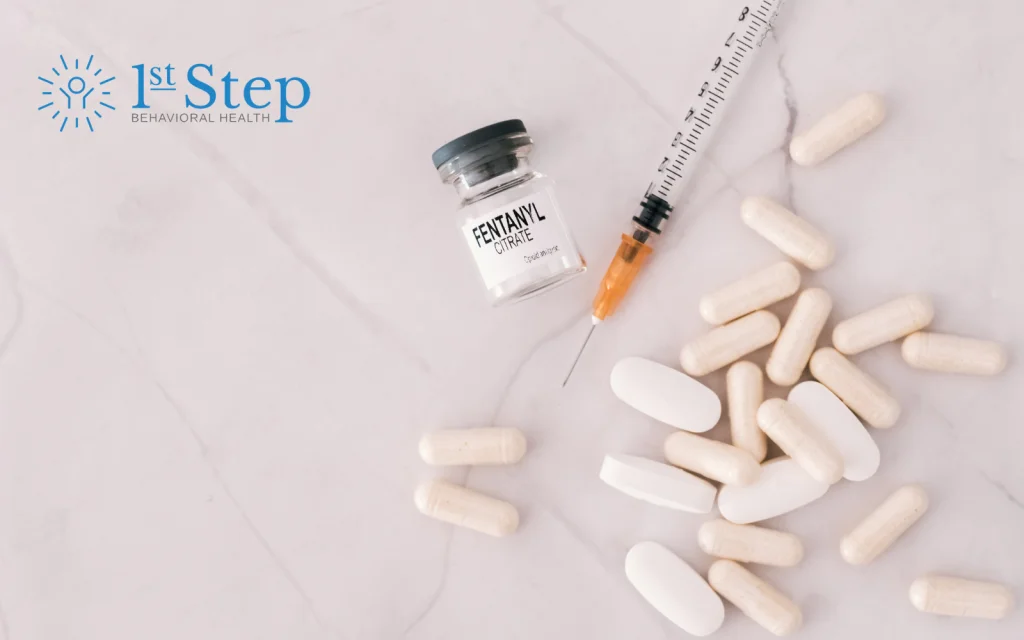The United States is in the midst of a fentanyl abuse crisis. Overdose deaths are on the rise as more people use fentanyl or are exposed to it while using other illicit drugs. 88% of the 80,411 opioid overdose deaths in 2021 were attributed to synthetic opioids, primarily fentanyl.[1]
Fentanyl is a powerfully addictive substance that can be lethal in tiny amounts. People should only take fentanyl as prescribed under careful medical supervision. Recreational use and misuse can quickly turn into a life-threatening medical emergency.
This article will explore fentanyl misuse and addiction. You will learn:
- The side effects and risks of fentanyl abuse
- How long fentanyl stays in your system
- How long drug tests can detect fentanyl in urine and other systems
- What to expect in fentanyl abuse treatment
- Where to find treatment and support for fentanyl abuse
Fentanyl addiction can be deadly. Don’t wait until an opioid addiction takes control of your life. Reach out to the First Step Behavioral Health team now to explore our fentanyl addiction treatment programs or to schedule an intake assessment.
Fentanyl Abuse: Understanding the Risks
Fentanyl is a synthetic opioid. Doctors may prescribe fentanyl to help patients manage pain after surgery or during treatment for other conditions. In most cases, doctors do not prescribe fentanyl for long-term use because it is highly addictive. However, fentanyl is widely available as an illicit drug sold on the streets. It often comes in the form of a fine white powder or is added to other drugs to increase the potency.
Fentanyl is available in several forms, including:
- Tablets
- Injectable liquid
- Patches
- Lozenges
- Nasal spray
- Powder (the most common form of illicit fentanyl)
Fentanyl is 100 times more potent than morphine.[2] Like other opioids, it binds to receptors in the brain in areas related to pain control, emotional regulation, and pleasure. It treats severe pain, but it also can produce a euphoric “high.”
People may begin taking fentanyl and become physically dependent on it. People who develop fentanyl addiction require comprehensive treatment programs to quit using the drug and avoid relapse.
How Long Do Fentany’s Effects Last?
The length of time you feel the effects of fentanyl can vary depending on the form you use. Fentanyl’s pain-relieving effects last from 1-2 hours when administered through an IV. A transdermal patch may relieve pain for up to 72 hours.[3]
Illicit fentanyl’s effects take effect faster and last a shorter period. People who use illicit fentanyl may only experience side effects for about 30 minutes. This may increase the risk of addiction or overdose because people may use it more frequently during a short period.
How Long Does Fentanyl Stay in Your System?
Fentanyl remains in your body even when you can no longer feel its effects. Fentanyl’s half-life (the time it takes for your body to remove half of the drug) is between 3 and 7 hours.[4] Medical experts believe it takes up to 35 hours for your body to clear fentanyl completely.[5]
Drug screening tests may be able to detect fentanyl in your system for longer periods. Here is an overview of how long different tests can detect fentanyl.
Urine tests
Urine tests are among the most common forms of drug screening in the United States. A urine test may be able to detect fentanyl for up to 72 hours after your last dose.
Saliva tests
Saliva testing is typically unable to detect the presence of fentanyl in your system consistently.
Blood tests
Blood testing is commonly used in medical settings. This form of testing has a short detection window of 5 to 48 hours after your last dose.
Hair testing
Hair testing has the longest detection window and may detect fentanyl for up to 90 days after your last dose.
Several factors can affect how long fentanyl stays in your system, including age, dosage, frequency, and metabolism. If you or someone you love abuses fentanyl, you must seek treatment as soon as possible to avoid life-threatening consequences.
What to Expect in Fentanyl Addiction Treatment
Fentanyl addiction treatment typically begins with a medically-supported detox. Fentanyl withdrawal can be very challenging. You may experience intense withdrawal symptoms, including:
- Appetite loss
- Nausea
- Elevated blood pressure
- Excessive sweating
- Insomnia
- Chills
- Muscle aches
- Anxiety
- Diarrhea
- Intense, constant cravings
During detox, medical and mental health professionals will monitor your withdrawal symptoms and provide treatment as needed. Your treatment program may include:
- Medications to reduce cravings and other symptoms
- Emotional support
- Round-the-clock supervision and access to treatment
- Holistic therapies, including mindfulness, massage, exercise, and nutrition support
Treatment during detox can increase your chances of having a complete detoxification.
Fentanyl withdrawal timelines can vary from person to person. However, symptoms tend to begin within 8 hours of your final dose of fentanyl. Symptoms can continue for several weeks or longer.
After completing fentanyl detox, you must transition into a comprehensive treatment program to help you address the underlying roots of your addiction. Treatment typically includes education, counseling, behavioral counseling, medications, and aftercare support.
Find Help Now
Fentanyl addiction can derail your life. Treatment can help. Reach out to the First Step Behavioral Health team now to explore your treatment options.
References:
- Centers for Disease Control and Prevention (CDC): Drug Overdose Deaths
- United States Drug Enforcement Administration (DEA): Fentanyl
- Science Direct: Chronic and Interventional Pain Management in Patients With Cancer
- National Institutes of Health (NIH): Fentanyl
- National Institutes of Health (NIH): Protracted Renal Clearance of Fentanyl in Persons with Opioid Use Disorder
Jump to a Section
Call (855) 425-4846
